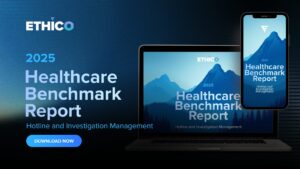Healthcare Edition: Unpacking The 2025 Benchmark Report 🧮🏥


Full Episode Available
WATCH ON-DEMANDHealthcare ethics and compliance is at a crossroads. The Healthcare Edition of The 2025 Hotline and Investigation Benchmark report reveals not just where we are, but the untapped potential of what we could become. This webinar unpacked how leading organizations are transforming their compliance functions from mere risk managers to strategic intelligence centers, and how metrics like case closure time, anonymity rates, and reporting channels can drive meaningful culture change—not just policy adherence.
This episode of The Ethicsverse presented the findings from the 2025 Ethical Health Care Hotline and Investigation Benchmark report, offering critical insights into ethics and compliance program effectiveness within healthcare organizations. The discussion explored various metrics such as case closure time, issue anonymity, reporting channels, issue categories, and substantiation rates, while highlighting strategies to enhance risk intelligence gathering, build organizational trust, and combat retaliation. The presenters shared practical approaches to leverage middle management, improve investigation processes, and ultimately “bend the curve” to make the next decade of ethics and compliance significantly more impactful than the previous one.
Meet The Ethics Experts:
- Leslie Boles, Co-Owner & President, Revu Healthcare
- Giovanni Gallo, Co-CEO, Ethico
- Nick Gallo, Chief Servant & Co-CEO, Ethico
Case Closure Efficiency
- Case closure time serves as a fundamental vital sign for overall program effectiveness, with the benchmark showing improvement from 27 days in previous years to 21 days, significantly outperforming the industry average of 42 days.
- Analysis revealed 77% of cases close within 30 days while cases in the over-90-day category dropped to 4.8%, suggesting better handling of complex investigations.
- Organizations seeking improvement should approach this as a business process optimization challenge, identifying specific bottlenecks, establishing differentiated response timelines based on case categories, and developing cross-functional partnerships to mobilize specialized expertise when needed.
Anonymity Rate as a Trust Barometer
- Anonymity rate accurately reflects organizational trust levels, with healthcare organizations in the benchmark achieving 73% identified reporting compared to the industry standard of 54%.
- This gap demonstrates how psychological safety translates directly into reporting behavior, with deep roots in healthcare where studies show correlations between speaking up comfort and improved patient outcomes.
- Organizations should analyze anonymity rates across different facilities and departments to identify trust deficits, implement targeted psychological safety interventions, and compare these metrics with exit interview compliance concerns to assess cultural health comprehensively.
Reporting Channel Use & Diversification
- The benchmark revealed healthcare organizations achieving 3.8 reports per 100 employees versus the industry standard of 1.6, with this increased risk intelligence coming through a diversified strategy capturing reports from hotlines (53%), web submissions (16%), and in-office reporting (31%).
- Despite technological advances, the data confirmed the persistence of human connection in ethics reporting, with many sensitive issues still reported via phone rather than digital channels.
- Organizations should measure channel abandonment rates (industry average 15-19% versus benchmark >1%) as a critical trust indicator and develop specific strategies to enhance each pathway’s information quality.
Issue Category Risk Indicators
- Benchmark data revealed significant shifts in issue categories with Privacy/Infosec and Fraud/Theft showing approximately 2.5% increases.
- Cross-tabulation analysis uncovered that customers predominantly report Environment, Health & Safety concerns (28% of customer reports) while employees focus primarily on HR issues (37.1% of employee reports).
- These patterns enable ethics programs to align their initiatives with broader organizational priorities such as patient satisfaction improvements and reputation management.
Issue Severity & Resource Allocation
- Issue severity distributions provide critical intelligence for resource allocation, with high-severity cases comprising approximately 17% of reports and showing correlation with healthcare sub-sector risk profiles.
- Patient-facing environments like Rehabilitation/Senior Care and Hospitals showed higher proportions of high-severity cases (23% & 15%, respectively) compared to Health Finances, Support services operations (2%).
- These severity distributions should drive differentiated investigation approaches, with specific protocols for high-severity cases and proper subject matter expert involvement.
Issue Substantiation & Investigation Effectiveness
- Issue substantiation rates showed significant improvement at 55% compared to the status quo of 45%, serving as a key indicator of investigation effectiveness.
- This “slow metric” revealed important correlations between substantiation rates and reporting channels, with identified reports showing significantly higher substantiation than anonymous ones.
- The benchmark emphasized implementing structured Corrective Action Plans following substantiated cases to ensure consistent consequence application, which both strengthens procedural justice and provides demonstrable evidence of program effectiveness.
Reporter Types & Stakeholder Expansion
- Reporter types expanded beyond traditional employee channels, with customer and related-party reporting increasing from 36% to 46% between 2020 and 2024.
- The analysis found particularly valuable intelligence coming from customers regarding Customer Relations, Business Quality issues, with 83% of business quality reports originating from customers rather than employees.
- This expanded approach enables ethics programs to reframe their value proposition beyond risk mitigation to include quality improvement and patient satisfaction enhancement, thereby aligning compliance goals more directly with broader business objectives.
Reporter Awareness & Promotional Effectiveness
- Benchmark data demonstrated significant shifts in how reporters become aware of ethics programs, with Internet resources (64%) now far surpassing traditional Printed materials (15%) and posters.
- Health finance and support services showed almost no impact from Printed materials while maintaining strong Word-of-Mouth awareness, suggesting sector-specific promotional strategies are necessary.
- Despite significant investment in formal Training/Orientation (15%), the benchmark emphasized that word-of-mouth remains critically important, indicating that positive reporting experiences significantly influence others’ willingness to engage.
Middle Manager Activation
- Middle managers represent the most significant untapped resource for ethics program effectiveness, with employees 6-8 times more likely to report concerns to managers than through formal channels.
- This “missing link” between tone at the top and buzz at the bottom prevents organizations from accessing vast amounts of risk intelligence, with available intelligence potentially 10-15 times greater than what formal channels currently capture.
- Effective activation requires systematic approaches including specialized training, communication toolkits, clear escalation procedures, and recognition of managers who effectively handle ethical concerns.
Anti-Retaliation Strategy
- Over 50% of employees who speak up experience or perceive some form of retaliation, making proactive anti-retaliation strategies essential rather than simply having zero-tolerance policies.
- This perception-based challenge requires addressing both actual and perceived retaliation through structured follow-up processes, explicit discussion during initial reporter contact, and systematic monitoring at 30, 60, and 90-day intervals post-report.
- Organizations should audit the consistent application of consequences across all levels, as employees closely observe whether high-status individuals receive the same treatment as frontline staff for similar violations.
Closing Summary
The 2025 Healthcare Hotline and Investigation Benchmark report illuminates the path forward for healthcare ethics and compliance professionals seeking to “bend the curve” and make the next decade significantly different from the previous one. By focusing on key metrics like case closure time, anonymity rates, and substantiation percentages, organizations can diagnose their program health and identify specific opportunities for improvement. The findings consistently highlight that true program effectiveness comes from building psychological safety, activating middle managers as ethical partners, implementing systematic anti-retaliation measures, and leveraging technology to direct limited resources toward the issues that matter most. Healthcare ethics professionals have a unique opportunity to align their objectives with their organizations’ broader missions of providing exceptional patient care, positioning ethics and compliance not as the “barnacle on the ship” but as the rudder that helps guide the organization toward both integrity and excellence. Through continuous improvement rather than destination thinking, ethics programs can transform from policy enforcers to strategic partners that enhance organizational performance while protecting what matters most.






































